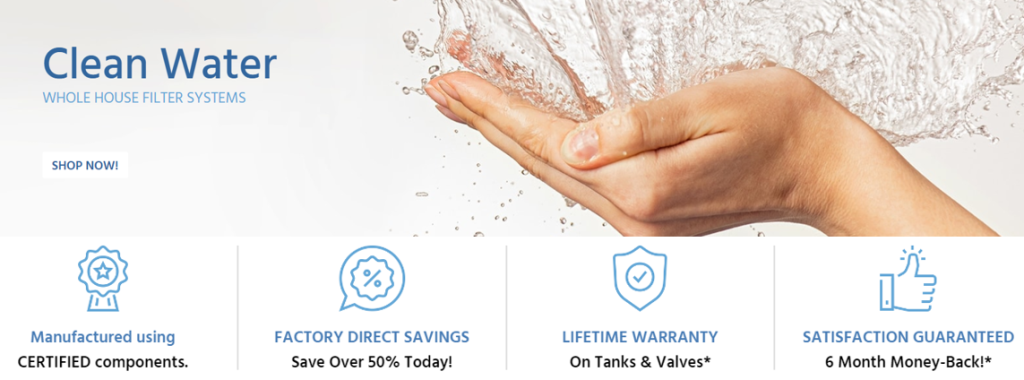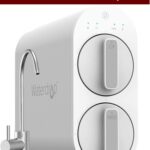The calcium is exchanged for sodium on the resin beads in the water softener.
A water softener is a device that removes calcium and magnesium ions from hard water. These ions are responsible for the hardness of the water. A water softener typically consists of a mineral tank and a brine tank. The mineral tank contains a bed of ion-exchange resins. The hard water flows into the mineral tank, and the calcium and magnesium ions exchange places with sodium or potassium ions on the resins. The sodium or potassium ions are then flushed out of the system with the wastewater. The brine tank contains a concentrated solution of salt (or sometimes potassium) and water. This solution is used to regenerate the ion-exchange resins. During regeneration, the sodium or potassium ions on the resins are replaced with calcium and magnesium ions. The calcium and magnesium ions are then flushed out of the system with the wastewater.
How Do Water Softeners Work?
Water softeners work by removing minerals from hard water, making it softer.

Water softeners work by removing the minerals that cause water hardness. The most common type of water softener uses ion exchange to remove calcium and magnesium from the water.
Install a Home Water Filter & Get "Unlimited Safe Drinking Water" For Decades
Get Upto 55% Discount With a Lifetime Warranty & 6-Months Money Back Guarantee Free Shipping
SpringWell Water Filtration Systems: 100% American-Made & NSF Certified Water Filters and Water Softeners
Ion exchange is a process where the water softener exchanges the hardness minerals for sodium or potassium ions. This process is completed by the water softener’s resin beads. The resin beads are made up of tiny cross-linked polymers that have a strong affinity for the hardness minerals.
As water flows through the resin beads, the calcium and magnesium ions are attracted to the beads and attach themselves to the beads. At the same time, the sodium or potassium ions are released into the water.
Once the resin beads are full of hardness minerals, they need to be regenerated. Regeneration is a process where the water softener flushes the beads with a concentrated salt solution. This flushing releases the hardness minerals from the beads and replaces them with sodium or potassium ions.
After regeneration, the water softener is ready to remove hardness from the water again.
How Do Water Softeners Remove Calcium Carbonate?
Water softeners remove calcium carbonate by ion exchange.
A water softener is a device that is used to remove calcium carbonate from water. Calcium carbonate is a common mineral that is found in water. It is also found in rocks and in the soil. Calcium carbonate can be a problem for people who have hard water. Hard water is water that contains a high level of calcium carbonate. This can make it difficult to clean clothes and to get the dishes clean. It can also make it difficult to take a shower or to wash your hair.
A water softener works by exchanging the calcium carbonate in the water for another type of salt. This salt is called sodium chloride. Sodium chloride is not as hard as calcium carbonate. This means that it will not make your clothes hard to clean or your dishes hard to clean.
There are two types of water softeners. One type is called an ion exchange water softener. This type of water softener exchanges the calcium carbonate in the water for sodium chloride. The other type of water softener is called a reverse osmosis water softener. This type of water softener removes the calcium carbonate from the water.
Ion exchange water softeners are the most common type of water softener. They are easy to use and they are not expensive. Reverse osmosis water softeners are more expensive, but they are more effective at removing calcium carbonate from the water.
If you have hard water, you should consider getting a water softener. A water softener will make your life easier and it will help you save money on your water bill.
How Do Water Softeners Remove Magnesium?
Water softeners remove magnesium by replacing it with sodium.
Water softeners are devices that are used to remove magnesium from water. This is done by exchanging the magnesium ions in the water for another type of ion, usually sodium. This process is known as ion exchange.
Water softeners are typically used in areas where the water is hard, meaning that it contains high levels of magnesium. Hard water can cause a number of problems, including clogging pipes and making it difficult to get soap to lather. Softening the water makes it easier to use and also extends the life of plumbing fixtures.
There are a number of different types of water softeners available on the market, including those that use salt to remove magnesium and those that do not. The type of water softener that you choose will depend on a number of factors, including the hardness of the water and the amount of magnesium that needs to be removed.
If you are concerned about the amount of magnesium in your water, you can have it tested by a water treatment specialist. They can also advise you on the best type of water softener for your needs.
How Do Water Softeners Remove Iron?
Water softeners remove iron by exchanging magnesium or calcium ions for the iron ions.
Iron is one of the most abundant metals on Earth and is a key component of steel. It is also found in water in two forms, dissolved iron and ferric iron. Dissolved iron is what gives water its reddish tint and is the type of iron that is most commonly removed by water softeners. Ferric iron is insoluble and gives water a cloudy appearance.
Dissolved iron is present in water as either ferrous iron (Fe2+) or ferric iron (Fe3+). Ferrous iron is the form that is most commonly found in nature and is the form that is most easily removed by water softeners. The iron is first oxidized by the water softener’s resin beads to ferric iron (Fe3+). The ferric iron is then attracted to the beads and is held there until the water is flushed from the system.
Water softeners are very effective at removing dissolved iron from water. However, they are not as effective at removing ferric iron. If ferric iron is present in high concentrations, it can clog the resin beads and reduce the efficiency of the water softener. In these cases, it may be necessary to install an iron filter in addition to the water softener.
How Do Water Softeners Remove Hardness?
Water softeners remove hardness by exchanging magnesium and calcium ions in hard water with sodium ions.
Water softeners are devices that are used to remove hardness from water. Hardness is caused by the presence of dissolved minerals, such as calcium and magnesium. These minerals can cause problems with plumbing and appliances and can make water feel sticky. Water softeners work by exchanging the hardness-causing minerals for sodium or potassium ions. This process is known as ion exchange.
One of the most common problems that water softeners solve is the build-up of scale on plumbing fixtures and appliances. Scale is a hard, chalky substance that is formed when water hardness minerals precipitate out of solution. Scale can build up on the inside of pipes and tanks, and on the heating elements of water heaters and other appliances. This build-up can reduce the efficiency of the appliances and, in some cases, cause them to fail prematurely.
Water softeners can also improve the quality of soap and detergent. Hard water interferes with the ability of soap to lather and can leave a film of soap scum on skin and laundry. Softening the water makes it easier to form a lather and also helps to prevent soap scum build-up.
In summary, water softeners remove hardness from water by exchanging the hardness-causing minerals for sodium or potassium ions. This process helps to prevent the build-up of scale on plumbing fixtures and appliances and also improves the quality of soap and detergent.
FAQ
How Do Water Softeners Remove Scale?
How Do Water Softeners Make Water Softer?
How Do Water Softeners Improve Water Quality?
Conclusion
Water softeners remove calcium by exchanging the calcium for another ion, typically sodium or potassium. This process is known as ion exchange.
If you’re still unclear about how water softeners work, please leave a comment below and I’ll be happy to answer your question.


